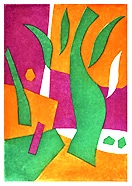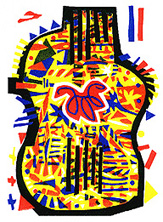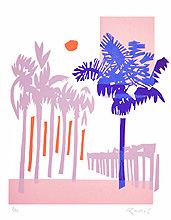


For the sake of my own paleness
I love red, yellow and blue.
Edith Södergran
"Color Longing"

(click on image for enlargement)

"Quartet"
(linoleum block print) $150

"Low tide"
(linoleum block print) $150

"Primary nonsense"
(aquatint etching) $150

"Secondary nonsense" (still life)
(aquatint etching) $150

"The painter's lyre I"
(linoleum block print) $150

"The painter's lyre II"
(linoleum block print) $150

"Him"
(linoleum block print) $185

"Her"
(linoleum block print) $185
 "Rincon suite I" (linoleum block print) $185 |  "Rincon suite II" (linoleum block print) $185 |
 "Mostar"(orange and blue) (linoleum block print) $185 |  "Mostar" (gray and black) (linoleum block print) $185 |
Note: Mostar, the capital city of Hercegovina in the former Yugoslavia,
was the birthplace of the artist’s Serbian grandmother. The 500-year-old
bridge which gave the town its name was destroyed in the Bosnian war.
"Eucalyptus" (linoleum block print) $185 | Rainforest" (linoleum block print) $150 |

Aquatint etchings on copper
(series based on Bach's Well-Tempered Clavier) $185
 "Prelude No. 1" |  "Fugue No. 1" |
 "Prelude No. 2" |  "Fugue No. 2" |
 "Prelude No. 3" |  "Fugue No. 3" |

 (lithograph on stone) $250 |
 "Warm litho" (lithograph on stone) $250 |
"Wind, water, fire, earth" Carpinteria suite I (linoleum block print) $185 |
 "Pier" Santa Barbara suite I (linoleum block print) $185 |

"Little fugue"
(collagraph/linoleum block print) $185

"Yucca in bloom"
(linoleum block print) $185

"Kiwi"
(linoleum block print) $150

"Astonished"
(linoleum block print) $185

"Bridge"
(linoleum block print) $150

"Brazil"
(linoleum block print) $150

"Fluid moments"
(aquatint etching) $200

"Sepia aquatint"
$185

"Eucalyptus II"
(linoleum block print) $185

"Sonata"
(linoleum block print) $185
(All prints hand-printed on fine-quality graphic arts paper)
(sent by registered mail)
Technical note: Many visual artists produce so-called "giclée prints." A special photograph is taken of the original artwork. This photo is then scanned into a state of the art computer especially tailored for this process. It is then printed with special inks on unstretched canvas or heavyweight water color paper. A finish is further placed on it for longevity. It is a very good technique for making posters. I do not use this technique, which I consider far-removed from the ancient tradition of hand-made prints, called le beau metier by master French artisans. Although photographic techniques have their place in print-making, true artisan print-making remains in close contact with the classical techniques used by Hokusai, Dürer, Rembrandt, Goya, Daumier, Whistler and modern masters of the print.
Printmaking often begins with a drawing of a master copy and is completed when that image is printed on paper. The technique varies depending on the materials, the tools and the processes used. Making multiple reproductions of the image, known as “pulls”, rather than creating a unique work of art, is one of printmaking’s main characteristics.
ETCHING
To make an etching, the metal plate is first covered with a layer of varnish and afterwards the image is incised into this layer with a needle that exposes the metal underneath. Next, the plate is dipped into an acid bath that bites into the unprotected metal from which the varnish has been removed. The surface of the plate is then inked with a soft scraper, forcing the ink into the crevices formed by the acid. After inking, the plate is printed onto paper.
DRYPOINT
In drypoint, the artist uses a needle to scratch an image directly onto a plate in much the same manner as one would draw with pencil on paper. However, the surface is more unyielding than paper and requires greater force and a steady hand. Once the image has been engraved into the metal, it is inked and then cleaned so that only the incisions are left holding the ink. The plate, when printed onto paper, converts those incisions into lines.
AQUATINT
Aquatint allows an artist to achieve a subtle range of tones. For this reason it is usually combined with etching or drypoint to obtain precise lines as well as areas with varying tonality. First, powdered resin is dusted onto the plate and adhered to the metal with heat. When the plate is dipped into an acid bath, the spaces left exposed between the resin granules are bitten, producing a slightly grainy, irregular surface which is then inked and printed onto paper.
The series above based on Bach’s Well-Tempered Clavier uses a process known as sugar-lift aquatint to create brushstrokes-like textures by painting on the plate with a brush soaked in a mixture of china ink and sugar. This is covered with varnish and immersed in warm water; the sugar swells and lifts the varnish from the painted areas which are bitten by the acid. Finally the plate is inked and passed through the printing press.
LITHOGRAPHY
Lithography involves drawing on a smooth dense stone with a grease pencil or lithographic ink. (See “Warm litho” and “Cool litho” above) The surface is then covered with a mixture of Arabic gum and water, and the stone is moistened with water and inked. The mixture causes a chemical reaction, allowing only the drawn areas to retain the ink, while the rest of the stone repels it. The work is completed with the impression of the final image.
LINOLEM BLOCK PRINT
Linoleum is a soft material, consisting of powdered cork and linseed oil which makes it easy to cut. The artist carves a drawing into a block of linoleum using a gouge, resulting in an image in relief. The block is then is inked with a roller, with the ink adhering only onto the raised areas. In contrast to other techniques that produce varied textures, when the linocut is impressed onto paper it creates areas of smooth, uniform colour. Linoleum printing is derived from the more ancient wood block printing.
Grateful acknowledgement to the Picasso Museum
in Málaga, Spain (Picasso’s birthplace) for the above information.COLLAGRAPH
Collagraph is a relatively new printing technique. It is a "collage" of a wide variety of materials glued together on a metal plate or flat piece of cardboard. Glue in French is "colle", root of collage and collagraph. The finished plate is a textured bas-relief that must be thin enough to go under the etching press. The inking of the finished plate can involve both the technique of etching above (wiping the ink into the deep parts), and linoleum printing (rolling ink onto the high parts). The printing proceeds in the same manner as etching. (See "Lyre", "Torso", "Fossil", "Blue goddess" and "Black V" on " More prints" page.)
SILK SCREEN
Silk screen (see “Wave” on “More prints” page) has its origins in Japanese stencilling, but the screen printing process that we know today probably stems from the patents taken out by Samuel Simon of Manchester at the turn of the century. He used silk stretched on frames to support hand painted stencils for multicolour printing. Many textiles and items of clothing, sports bags and T-shirts have been screen printed, as well as stickers and labels encountered everywhere.
The equivalent of the printing plate for the screen printer is the screen - a wooden or aluminium frame with a fine nylon mesh stretched over it. The contour of the image is painted with stop-out varnish or applied by photographic means onto the mesh. This leaves an open stencil which corresponds exactly to the forms of the color to be printed. Now the screen is fitted on the press and is hinged so it can be raised and lowered. The paper is placed in position under the screen and ink is placed on the top side of the screen. A rubber blade gripped in a wooden or metal handle called a squeegee (not unlike a giant windshield-wiper) is pulled across the top of the screen. It pushes the ink through the mesh onto the surface of the printing paper. The process is repeated for each color.

watercolors
oil paintings
collages
early works
monoprints


syukhtun.net domain name is trade marked SM, All Rights Reserved
|
|
xxxxxxxxxxxx





